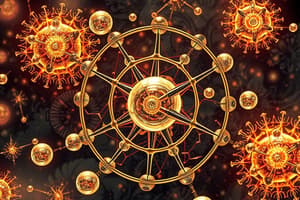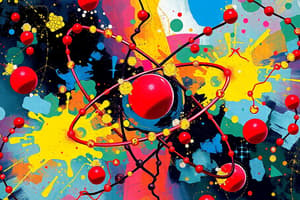Podcast
Questions and Answers
What determines the identity of a particular element?
What determines the identity of a particular element?
- The number of neutrons
- The atomic mass
- The number of protons (correct)
- The number of electrons
Which particle has a mass that is approximately negligible compared to protons and neutrons?
Which particle has a mass that is approximately negligible compared to protons and neutrons?
- Electrons (correct)
- Neutrons
- Nucleons
- Protons
What is the mass number of an atom if it has 6 protons and 7 neutrons?
What is the mass number of an atom if it has 6 protons and 7 neutrons?
- 11
- 12 (correct)
- 6
- 13
Which of the following correctly describes isotopes?
Which of the following correctly describes isotopes?
In which part of the atom do protons and neutrons reside?
In which part of the atom do protons and neutrons reside?
What represents the principal quantum number in electron shells?
What represents the principal quantum number in electron shells?
What occurs when atoms strive for a stable electron configuration?
What occurs when atoms strive for a stable electron configuration?
How many neutrons are present in a carbon-14 atom?
How many neutrons are present in a carbon-14 atom?
Which of the following statements is correct regarding atomic mass?
Which of the following statements is correct regarding atomic mass?
Why do atoms form chemical bonds?
Why do atoms form chemical bonds?
Flashcards
What is an atom?
What is an atom?
The basic building block of matter, consisting of protons, neutrons, and electrons.
What is the nucleus?
What is the nucleus?
The positively charged core of an atom, containing protons and neutrons.
What is a proton?
What is a proton?
Positively charged particles found in the nucleus of an atom.
What is a neutron?
What is a neutron?
Signup and view all the flashcards
What are electrons?
What are electrons?
Signup and view all the flashcards
What is the atomic number?
What is the atomic number?
Signup and view all the flashcards
What is the mass number?
What is the mass number?
Signup and view all the flashcards
What are isotopes?
What are isotopes?
Signup and view all the flashcards
What is the electronic structure?
What is the electronic structure?
Signup and view all the flashcards
What is chemical bonding?
What is chemical bonding?
Signup and view all the flashcards
Study Notes
Atomic Structure Overview
- Atoms are the fundamental building blocks of matter, composed of protons, neutrons, and electrons.
- Protons and neutrons are located in the nucleus, the atom's positively charged core.
- Electrons orbit the nucleus in specific energy levels or shells.
- The number of protons in an atom defines its atomic number and identifies the element.
- Atoms of the same element with differing neutron counts are called isotopes.
- Atomic mass is the sum of protons and neutrons in an atom's nucleus.
- Atoms typically strive for a stable electron configuration by gaining, losing, or sharing electrons with other atoms to form chemical bonds.
Subatomic Particles
- Protons: Positively charged particles within the nucleus; mass approximately 1 atomic mass unit (amu).
- The number of protons defines the element.
- Neutrons: Neutrally charged particles within the nucleus; mass approximately 1 amu, slightly greater than a proton's.
- The number of neutrons varies among isotopes of the same element.
- Electrons: Negatively charged particles orbiting the nucleus in specific energy levels (shells); mass is much less than protons or neutrons.
- Electrons dictate an atom's chemical properties.
- Electron shells are labeled with principal quantum numbers (e.g., n=1, n=2, n=3...).
Atomic Number and Mass Number
- Atomic Number (Z): Number of protons in an atom's nucleus; uniquely identifies each element.
- Example: Carbon has an atomic number of 6, meaning 6 protons.
- Mass Number (A): Sum of protons and neutrons in an atom's nucleus; approximate atomic mass. Note: approximation due to presence of electrons.
- Example: A carbon-12 atom has atomic number 6 and mass number 12 (meaning 6 neutrons).
Isotopes
- Isotopes are atoms of the same element with the same number of protons but different numbers of neutrons.
- They possess identical chemical behavior (react similarly) but exhibit slight variations in physical properties (mass, reactivity).
- Example: Carbon isotopes include carbon-12, carbon-13, and carbon-14.
Electronic Structure
- Electrons occupy specific energy levels (shells) surrounding the nucleus.
- Shells have increasing energy levels.
- Each shell can hold a maximum number of electrons (2n^2, where n = shell number).
- Electron arrangement critically affects chemical behavior.
Shells and Subshells
- The shell model shows electrons orbiting in discrete shells.
- Reality also has subshells (s, p, d, f) within each shell where electrons reside.
- Each subshell has a specific shape and energy level.
- This substructure is essential for understanding chemical bonding.
Studying That Suits You
Use AI to generate personalized quizzes and flashcards to suit your learning preferences.




